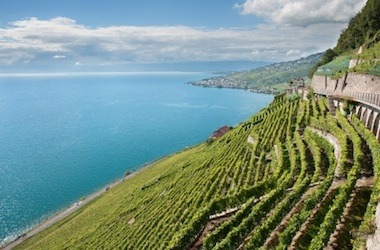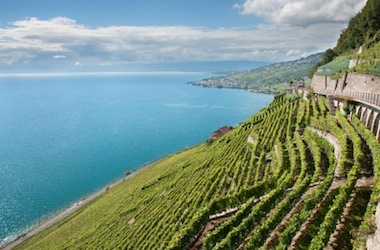The Unexpected, Very Good Wines Of Switzerland
Imagine a whole new world of wine, from a country you probably didn't think even grew grapes. Imagine not just a few kinds of wine, but scores of different whites, rosés, and reds, some based on old friends like pinot noir and chardonnay, but many of them made from varietals you've likely never heard of — grapes with names like chasselas, petite arvine, amigne, humagne rouge, cornalin, and diolinoir. Imagine that the best of the whites are crisp and lively, but also complex, with an attractive mineral edge; and that the reds are either delicate and floral or earthy and full without being inky or thick; and that the rosés are so subtle that they're not even called rosé (meaning pink), but oeil de perdrix, eye of the partridge, for their pale ambiguous iridescence.
You have just imagined Switzerland, land of cuckoo clocks, chocolate, cheese with holes in it, snowy Alps — and a fair quotient of really, really good wine.
Why aren't Swiss wines better known? First of all, because while they exist in surprising variety, there aren't a whole lot of bottles produced. The country's total yield is just over 1 million hectoliters (a hectoliter is 100 liters, a little more than 26 gallons) annually. The U.S., by way of comparison, produces something like 20 million, and Italy, the world's largest wine producer, turns out more than twice that. On the other hand, Switzerland boasts the eighth largest per capita wine consumption of any country in the world (38.14 liters in 2009, compared to America's measly 8.96). Small amount of wine + big thirst = Why should we let anybody else have any of the stuff?
But there's another problem: Unfortunately, when the Swiss do let a little of their better stuff escape their borders, it tends to be pretty expensive — not expensive for its ultimate quality in most cases, but expensive for wine made from grapes nobody's heard of, in the capital of cuckoo clocks. Prices are high not just because production is small and indigenous demand is high. The wines tend to be expensive to produce, because vineyard plots are small and often steep, so labor is arduous and must be done by hand — and Swiss agricultural workers are probably the highest paid in Europe.
Price and obscurity notwithstanding, some of Switzerland's better vintages have been imported into the U.S. over the years. In the 1990s, there was even a short-lived Swiss Wine Information Council in New York City — under the direction of a cosmpolitan wine importer and onetime director of the Academie du Vin in Paris named Melissa Seré — charged with stimulating sales of Swiss wines in this country. For a year or so, there were suddenly examples on wines lists at some of the best restaurants in Manhattan — Daniel, La Caravelle, the Four Seasons, and the like. To say that they didn't exactly slalom out the door would be understatement. "The wines sold a little through Swiss businesses and Swiss-trained hotel people," says Tim Enos, a retired CEO and current board member of the venerable firm of Dreyfus, Ashby & Co., which imported several of the most important Swiss brands. "That was about it."
Dreyfus, Ashby & Co. was founded in the mid-20th century in London by a Swiss hotelier named Michel Dreyfus and an English partner, a Mr. Ashby, about whom nobody seems to know anything. First in the UK and later in America, the firm represented some of the great old-line French producers, including Faiveley, Hugel, Krug, and the Comte de Vogüé. To help a friend, Dreyfus also took on a simple, lightly sparkling rosé from Portugal called Mateus — which became more or less the Yellow Tail of the 1970s and '80s. Dreyfus added some key Swiss brands to the portfolio, says Enos, apparently because they were served on Swiss trains at the time. (Dreyfus, Ashby & Co. is now owned mostly by the big Burgundy shipper Robert Drouhin, with 10 percent held by the Spanish wine giant Torres.)
"We were probably the only ones doing anything with these wines for years," adds Enos, "until Melissa came along and did such a good job." Unfortunately, though Seré was successful in installing Swiss wines in all the right places, they sold poorly. "I think these wines are charming and fun, " Enos continues, "but I was probably in the minority even within the company." The problem, he says, is that "they're relatively expensive, and nobody knows what the hell they are."
(Image courtesy Flickr/Tom Anderson)
The emblematic white-wine grape of these regions is chasselas. Grown today, often in modest quantities, sometimes as a table grape, in France, Germany, Portugal, Hungary, Turkey, New Zealand, and even Mexico, among other places, it is the most widely planted grape in Switzerland, and is believed by some authorities to be of Swiss origin. (Others think it came from Egypt originally.) If it is little-known beyond Switzerland's borders, it might be because, according to the Vitis International Variety Catalogue, there are more than 200 synonyms for its name, from abelione to zupljanka. It has certainly found its most hospitable home, in any case, in the Vaud, Valais, and Neuchâtel regions in which it is capable of producing wines of real distinction and complexity.
In the Valais, the grape is called fendant, and one of the best examples from the canton, now available in the U.S., is Robert Gilliard Les Murettes 2009 ($28), a crisp, sunny wine with a faintly floral nose and an attractively sharp mineral-tinged finish. Château d'Auvernier Blanc 2009 ($25), from Neuchâtel, is based on a chasselas clone called fendant roux. The wine is light and citrusy, with the faint pinpoint carbonation the French call pétillance. Henri Badoux Aigle les Murailles 2009 ($38) from the Vaud ups the ante; this is a much richer wine than the Gilliard or the Château d'Auvernier, with a nice concentration of fruit, a mineral quality on the palate, and a lingering finish. The most celebrated chasselas-based wine of the Vaud is Dézaley (the appellation was one of the first two vineyard sites in Switzerland, along with its neighbor Calamin, to win Grand Cru status). Louis Bovard's La Médinette is, to me, the paragon. In its absence on American shores, we can do very well with J. & P. Testuz L'Arbalète 2009 ($53). Like other good Dézelay, the L'Arbelète performs the neat trick of being intensely aromatic in a blossomy way that recalls good viognier and rich and round in the mouth, but at the same time somehow crisp, clean, and almost steely.
The Vaud produces wonderfully elegant pinot gris as well. Henri Badoux's Jeu du Roy, a big, sturdy, complex, high-alcohol version, stands out in my memory as one of the best examples of pinot gris I've ever tasted — but Dreyfus, Ashby & Co. doesn't bring it in. They do import a very nice medium-bodied one from 2009 Château d'Auvernier ($32), silky and fruity. Château d'Auvernier's 2009 Oeil de Perdrix ($32), based on pinot noir, is a pale, fresh rosé, charming if not exactly exciting.
Swiss pinot noir is not for fans of big, extracted, California- or Spanish-made interpretations of the grape. They tend to be light, almost evanescent wines with a faint earthy flavor and light but true varietal character. The 2008 Château d'Auvernier Pinot Noir ($32) is light, tasty, almost frivolous — the kind of wine you'd want to drink slightly chilled. Robert Gilliard Dôle des Monts 2009 ($31) is about 80 percent pinot noir, the rest being gamay. It, too, is light, though a bit more substantial than the Château d'Auvernier, and has an intense strawberry-ish nose and some good berry fruit.
A few other Swiss labels occasionally found in the U.S., from other importers than Dreyfus, Ashby & Co., include Rouvinez and Jean-René Germanier from Valais and Les Frères Dubois et Fils from Vaud (their specialty being a suave chasselas-based epesses — a close cousin of Dézelay — with the daunting name La Braise d'Enfers, "The Embers of Hell"). These and the aforementioned wines might be difficult to track down, and as noted will cost more than you may be inclined to pay for wines you've never heard of, but they do offer some wonderful change-of-pace wine-drinking experiences.
"When we first started pouring Swiss wines at wine fairs around the world," the former CEO of Robert Gilliard, Claude-Nicolas Becker, once told me, "People laughed and passed us by. The next two or three times they'd pass by with just a smile. Now they come with their glasses held out."

